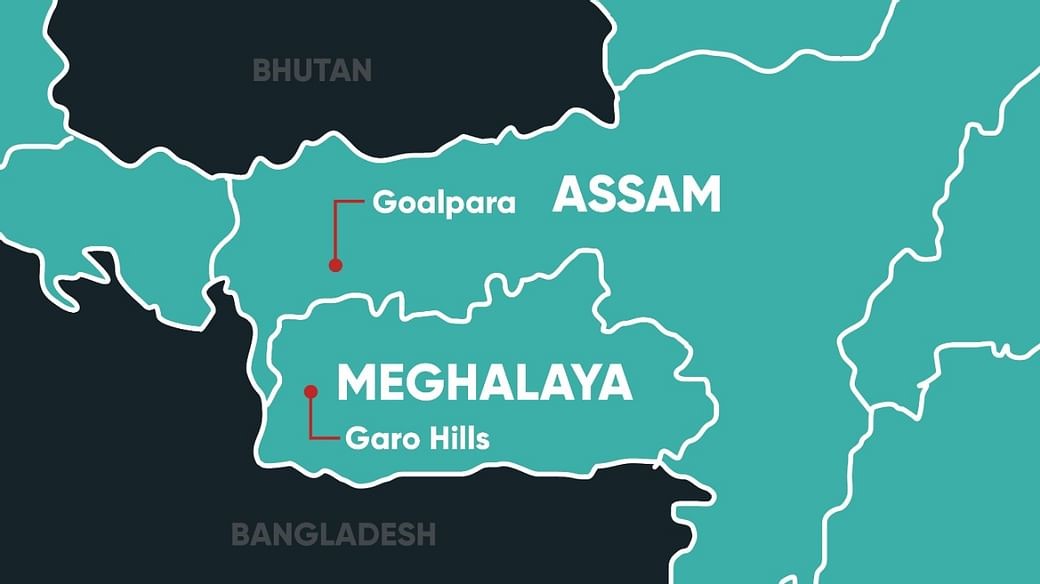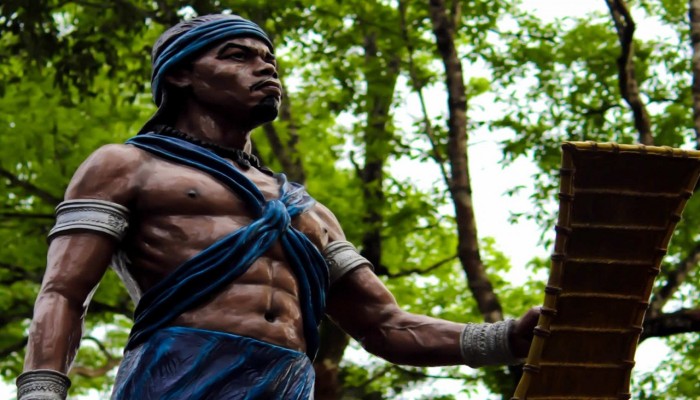Pa Togan Nengminja Sangma – Another Forgotten Son of India who Challenged the British Might in Meghalaya Part 1
- In History & Culture
- 11:51 PM, Dec 12, 2020
- Ankita Dutta
In few of my previous articles on the culture and history of Northeast India, the major point of focus has been on the Sanatan Hindu roots of this part of the country which is now largely Christian-dominated. Although the Church has established a strong foothold for itself especially in the hill states of the Northeast, Hindu religious beliefs and practices still remain vividly alive among different groups and communities of people here. This is a fact which is certainly not to be overlooked in any discussion of the history, society and culture of the people of the Northeast. Since the colonial times, they have not only vehemently resisted the assault on their traditional faiths and belief systems by the Europeans, but also, in their own unique ways, challenged the might of the colonial state to alienate them from their cultural and civilisational belongingness with Bharat. Despite the various differences that exist on the surface, the idea of Bharat as one single entity has always been and still is culturally present in every single village and among every janjati community in the Northeast.
But, the contributions and continued struggle of India’s Northeast to help liberate the country from the clutches of the British rule and also preserve their own distinct ways of lives, have failed to find a space in the dominant discourse of the post-Independent Indian state. Unfortunately, it is this same discourse that has kept its political shops running by portraying Northeast India and its inhabitants as being “outside” of the narrative of what it means to be an “Indian”. It is precisely because of this reason that stories of anti-colonial struggles at the local level from this enchantingly beautiful part of the country have never featured in the mainstream Indian nationalist history writings. Before undertaking a study of the different resistance movements that sprang up in the Northeast at different time periods against an alien cultural and religious force, one needs to understand the cultural gaps and inconsistencies of thought and value systems that existed among the natives and the Europeans. These movements challenged European values, ideas and ideologies under the leadership of some lesser-known, yet quite valiant freedom fighters who voluntarily chose death over surrender.
The story of India’s freedom struggle is not merely about a handful of foreign-educated, English-speaking, graduates; it is as much about them as it is about those heroic freedom fighters who represented the epitome of Kshatriyahood at its best. Their fight was all about saving their community’s pride and identity from silent usurpation by a foreign faith in the hands of the colonialists.
Besides Sonaram Sangma, Pa Togan Nengminja Sangma (also known as Togan Sangma) is another still yet unknown to many and less talked-about freedom fighters from the Garo Hills in the Indian state of Meghalaya, literally meaning ‘The Abode of Clouds’. These two Garo leaders are well-known throughout the Garo Hills and revered till this day for their meticulous organisation of anti-colonial resistance movements more than a century ago, i.e. in the late 1800s and the early 1900s. The Garos were traditional head-hunters who are now classified within the category of ‘Scheduled Tribes’ in Meghalaya. A sparsely populated, landlocked hilly state situated along the south-western borders of Assam and Bangladesh, Meghalaya is one of the most sought-after tourist destinations in Northeast India for its resplendent natural beauty and breath-taking landscapes.
The Garos are one of the three major indigenous groups of Meghalaya, besides the Khasis and the Pnars (Jaintias). There exist five major clans among the Garos – Sangma, Marak, Momin, Arengh, and Shira – which are further sub-divided into many different sub-clans.
In terms of the size of their population, the Garos constitute the second largest community of people (almost 1/3rd of the population) in Meghalaya after the Khasis. It is believed that a division of the Garos called themselves by the name of Gara, which became Garo over time. Regarding their original homeland, no one knows exactly as to where they came from, although a popular legend has a very distinct story to tell about the Garos migrating from what is today called Tibet. The belief is that Garu, who was the leader of the migrants, gave his name to the community after they settled down in different areas of the Brahmaputra river valley. Interestingly, in one of the old Garo songs, there is a reference to the country of their origin as Garu – a song or a country of the Garos. Similarities of language, customs and beliefs among a section of the Tibetans and the Garos, do indicate their linkages with Tibet in the olden times.

Picture Credits: The Northeast Today
There are large groups of Garos inhabiting the contiguous plains areas of Habraghat Pargana, covering the present-day district of Goalpara and a few areas of Kamrup district in Lower Assam around Guwahati along the north and the south banks of the Brahmaputra, besides Darrang, Lakhimpur, Sibsagar, and Karbi Anglong districts. A sizeable population of the Garos can also be found in the areas of the West Khasi and the East Khasi Hills districts in Meghalaya. Along with the Hajongs, Rabhas, and Banias, they are scattered over a few localities of Dimapur in Nagaland. They are also to be found in a small number of districts in Tripura and West Bengal such as Cooch Behar, Darjeeling, Jalpaiguri, and Dinajpur; and, Chittagong, Jamalpur, Tangail, Maulavibazar, and Dhaka districts of Bangladesh too. The Garos share a close linguistic affinity with numerous other indigenous groups and communities residing in the plains of Assam, including the Koch-Rajbongshis, Kacharis, Dimasas, and Bodos.
Beginning of a Simmering Discontent
British colonial rule had a tremendous impact on almost all sections of the Indian society. Just like many other communities from Northeast India (e.g. Khasis, Jaintias, Nagas, Lushais, etc.), the Garos too, have mounted bold and daring battles of resistance against the British rule and its associated oppressive practices such as the zamindari system. They resisted because they suddenly began to feel the heat of the changes introduced by the colonial administration in their area. Their rights to land, livelihood and natural resources were being taken away. These are awe-inspiring local stories of local leaders who selflessly fought against the British through their own innovative local techniques of struggle, keeping in mind the available resources, terrain and weather conditions of the area. Most of the popular resistance movements in colonial India were aimed at the restoration of old structures, relations and ways of lives of the people which the British wanted to overthrow.
However, contemporary historical narratives of the Indian freedom struggle have, for the most part, relied upon the already biased and discriminatory accounts of the British colonialists. This has resulted in a deliberate ignorance and suppression over time of the different local histories of different geographical regions of the country. The latter have largely been kept alive through either folklore or oral historiography prevalent in the particular region/area. Hence, outsiders have remained aloof from much of these stories, thereby acting as a serious dent on achieving real national integration. It is to be noted here that the oral tradition of the Garos has served as a veritable vehicle for passing on historical accounts, folk songs and narrations, lullabies and sayings, riddles and proverbs, etc. to the successive generations.
The pristine Garo Hills (because Garos constitute the majority of the inhabitants of the district) was a part of the former undivided state of Assam until April, 1970. On April 2, 1970 Meghalaya was inaugurated as an autonomous state for the first time. It achieved full-fledged statehood much later on January 21, 1972 when it became the 21st state of the Union of India. It was in October 1976 that the erstwhile Garo Hills district with its headquarters at Tura, was bifurcated into two administrative districts, viz. West Garo Hills district and East Garo Hills district, their names being determined by their geographical location on the map of the entire Garo Hills area. This was done primarily with the aim of bringing the administration closer to the people. Culturally, the Garo Hills represent a transition between the civilisation of Bharatvarsha and that of South-East Asia.
Popularly, the Garos call themselves as A’chik-mande (A’chik meaning hill; and, mande meaning man) and never as Garos, only except in conversation with any outsider. The land that they inhabit is thereby known as A’chik land. Hence, it may be safely assumed that the term ‘Garo’ has been given to them by others. The A’chiks/Garos are one among the very few remaining matrilineal societies across the world, implying that clan lineage and clan titles in their community are passed on to the offsprings from their mother.
Togan Sangma was a 19th century Garo (A’chik) warrior who selflessly laid down his life battling the British forces on December 12, 1872. He was born in the village of Samanda near Shillong’s Williamnagar, which is the headquarter-complex of the East Garo Hills district of Meghalaya that falls under the Tura Parliamentary constituency. Togan Sangma was a gigantic man blessed with a well-built muscular body and physical combat capabilities. Christian missionary groups active in the Northeast, in their attempt to appropriate local traditions and histories of the region to suit their own ominous designs, have often compared the warrior in Sangma to that of the Biblical Philistine giant Goliath. In fact, the extent of this appropriation can be understood from the fact that it has now become commonplace to come across different writings on Togan Sangma where he is being referred to as the ‘Garo Goliath’!
In such a process, it is not only the real history of the region and its people that gets concealed, but it also works as a silent psychological tool of invading the minds of the natives who eventually become a disconnected lot from their own cultural and historical past.
It may be recalled here that the American Baptist Missionaries were the first to have come to the Garo Hills after the British occupation of this district was complete in 1872. With the aim of propagating their Christian dogma through education as the means, they first learned the A’we and A’Tong dialects of the Garos which were then used to write school textbooks. The Bible was translated so as to make it the standard literature in the Garo language and establish Jesus as the Supreme God. The rich cultural repository of epic narrations of the Garos known as Katta Agana or Katta Doka and folk songs of various kinds, were also translated by the Christian missionaries into the local Garo dialects. In due course of time, elements of the Garo traditional religion called Songsarek which could not be comprehended by the Christian missionaries were dismissed as ‘superstitious’ or ‘irrational’, while the rest were digested into the Christian theological and religious doctrine. Today, a majority of the Garos have become Christians (with the majority being Catholics) and several ritualistic elements of their folk theatre traditions such as kirtan and sankirtana have been appropriated into the Christian literary and religious framework.
In 1872, British soldiers had entered the area of the Garo Hills. They set up a camp at a nearby village called Matchu Rongrek, situated near the picturesque Chiso-Bibra (originally known as Chisobibra/Sisobibra or ‘Dying Junction’, for Togan Sangma die there) and waited for the right time to strike. Chisobibra is located on the left bank of the river Simsang (the longest in the Garo Hills) at the confluence of the Chiso rivulet near Rongrengiri Reserve Forest, which is situated in close proximity to Williamnagar. It was at Chisobibra that the British faced the last major Garo resistance to their intrusion during the pre-Independence period.
A Flashback of the Events
Prior to this event, the British Government had appointed many tributary chiefs or zamindars to collect taxes and tribute from the common village-folk. The surrounding plain areas of the Garo Hills subsequently came under the authority of the zamindars, who further sought to extend their jurisdiction into the hills. Before the introduction of the zamindari system by the British administration in the Garo Hills, all the civil and criminal cases were tried and settled by chiefs known as A’King Nokmas, who were assisted by the village Nokmas (headmen) and their Councils. The overall responsibilities of civil administration, administration of justice and looking after people’s welfare, were all vested upon the A’King Nokmas. They were independent of one another and thus subject to no higher authority above them. Village elders had the opportunity to voice their grievances in the bichal/melaa (meeting), which pronounced oral judgements that were binding on the offender. Decisions were arrived at as per the prevailing customary laws and practices. But, this state of affairs underwent a drastic change with the arrival of the land tenure system of the British Government.
The fiercely independent Garos who were till now dependent upon their close-knit self-sustaining economy, could not accept the fact that they were being forcibly dragged under the rule of a foreign power. A widespread sense of distrust had come to prevail among the native inhabitants of the area with the presence of Roris (white-skinned outsiders, e.g. traders, moneylenders, and contractors). The cries of Rori rang sokbajok (‘Outsiders have Reached’) by women began to be heard often. Elders of the villages held urgent meetings to discuss and devise a novel way to counter this new threat. Suddenly, a rumour spread like wildfire that a new kind of hollow sword with a sound similar to that of Kimpreta (thunder), produced fire that was capable of burning the entire human body. Such a sword was used by the outsiders to attack the natives. Hence, all the villages were strictly instructed to be on guard.
In an unapologetic show of resistance, the Garos put up a fight against the imperialistic policies of the British Empire. This led to a series of murders and bloodsheds on the outskirts of the Garo Hills. Extortions became a regular feature at the weekly markets (haats), which resulted in constant squabbles between the Garos and the zamindars that remained unabated for a long time. During the 1850s, numerous raids were carried out by the Garos in the plain areas of Goalpara in neighbouring Assam and in Mymensing district of present-day Bangladesh. In those days, violence and plunder were the two most popular tools used by the rebels to express their anger and dissatisfaction against their oppressors. The British government, in return, took several steps to bring these conflicts to an end by appointing a Garo leader named Rengta as a zamindar under the rule of the English East India Company in 1790. But, the vehement opposition of the Karaibari zamindar to this move ensured that it remained a futile exercise. In the year 1816, the government sent one David Scott (who was then the Senior Commissioner of Lower Assam and political agent to the Governor General on the North-eastern frontier of Bengal) as a Special Commissioner to settle the unending conflicts between the Garos and the zamindars.
Although Scott did not completely succeed in establishing peace, he introduced a new regulation according to which the Garos were exempted from paying tribute to the zamindars. However, the latter continued to oppress the Garos as before which led to another fresh wave of turbulence in the area.
Contd...
Image Credit: Official Holidays







Comments